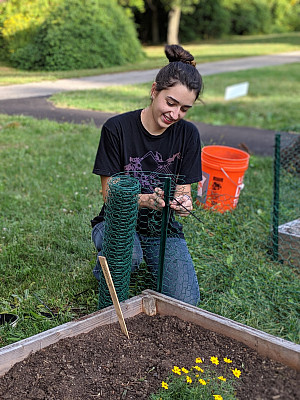Working in the Native Pollinator Garden at Suny Purchase. by Sam Scalice
January 02, 2020
Open gallery

This semester, I had the opportunity to work beside Dr. Jackson, a professor in the Environmental Studies Department, in the new native pollinator garden located in the field between the Neu and the dance building. Last year, a group of students along with Dr.Jackson, set out to do something great that would provide huge benefits for local pollinators— organize and plant a native plant garden!
By planting flowering native plants, we are helping pollinators such as bees, butterflies, and even birds get the nutritious pollen they desire, while at the same time providing a necessary service for native plant reproduction (Ollberton et al. 2011). Being that our planet is currently experiencing a global change in temperature, it is imperative that we assist pollinators in survival in any way that we can (Harrison and Winfree 2015). The goal is for these plants to be able to survive and provide benefits for the ecosystem completely on their own, however our garden needed some T.L.C in the beginning phases to help it get established. The garden beds were built and filled with compost and native plants by students here in the spring semester of last year, however over the summer some of our rabbit friends decided they like the garden just as much as we do! Our wildlife cameras caught the fluffy, hoppy culpits in the act of snacking on our beloved native plants! We needed to do something to stop the invasive bunnies from making the garden into an all you can eat buffet, hence the first project of the semester, bunny fencing and replanting.
Because this garden is a community resource, we wanted to get the Purchase community involved as much as possible. I was very impressed and pleased with the turnout of people that came out to support the garden on replant and fence building day. Everything was looking really great by the time everyone left that night. However, the next few weeks were dry and hot and that proved to be a challenge for the survival of these plants. Many of the plants, particularly the freshly replanted ones, seemed to be wilting drastically. We had specifically planted in the fall so that the plants would have plenty of rainwater to keep them hydrated, but there was an uncharacteristically dry spell that we had not accounted for. All we could do was manually water the plants as frequently as possible and eventually they started to come back to life. Then, once the Fall rain finally did come, the plants began to do better— but so did the weeds. There was a period of time just before the first frost of winter where the weeds seemed to just kept coming back no matter how many I pulled, but eventually the cold hit and the weeds died.
In addition to the physical work done in the garden, I also had the opportunity to do some research on native and invasive plants, and why it is important to establish native pollinator gardens for a multidisciplinary science communication project involving the garden that is currently in the works. It was very interesting to see how the ecosystem benefited from each plant and also how the plants were used throughout history and now. One thing that I learned that I thought was amazing was that monarch butterflies, the quintessential butterfly that pops into everyone’s heads when hearing the word, is reliant on one specific type of native plant called milkweed. Without milkweed, monarchs would not be able to reproduce and continue existing! Additionally, I found it to be fun and challenging to try to think from the perspective of someone who is not a scientist to try to best communicate the importance of the native plants. I hope that the work I did during this semester helps pave the way for citizens of the Purchase College community to learn more about the organisms and ecosystems around them and become more involved with nature.
More reading on native plants:
Ollerton, J., R. Winfree, and S. Tarrant. 2010. How many flowering plants are pollinated by animals?. Oikos 120: 321–326
Harrison, T., and R. Winfree. 2015. Urban drivers of plant-pollinator interactions. Functional Ecology 29: 879–888